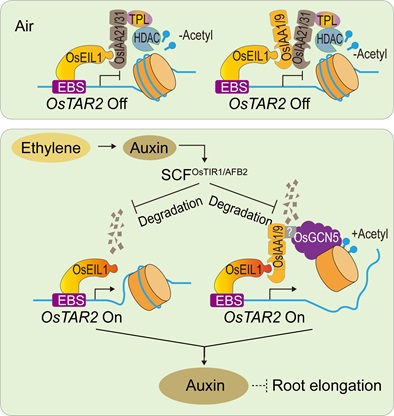A research team led by Prof. ZHANG Jinsong from the Institute of Genetics and Developmental Biology (IGDB) of the Chinese Academy of Sciences (CAS), has been devoted to the studies of ethylene signaling pathway and its regulation in rice (Oryza Sativa, L.) for a long time. Recently, they disclosed a new crosstalk between the phytohormones ethylene and auxin at a previously underappreciated level. This study was published in The Plant Cell on Aug. 16 (https://academic.oup.com/plcell/advance-article/doi/10.1093/plcell/koac250/6668345).
Ethylene plays important roles in the environmental adaptation of plants. Auxin is essential for plant development. Rice is an important food source especially for Asian countries. For more than three decades, the ethylene signaling pathway has been extensively studied using the phenotypic change in “triple response” of Arabidopsis (Arabidopsis thaliana). Rice (Oryza Sativa, L.) is a semi-aquatic monocot. The ethylene responses of its young seedlings normally show the so-called “double response”, namely promoting the coleoptile/mesocotyl elongation whereas inhibiting the root elongation.
In recent years, through the analysis of a series of mao hu zi (mhz) mutants, Prof. ZHANG’s lab has identified the ethylene signaling pathway in rice. The major components of this pathway are very similar to those in Arabidopsis. However, his team also discovered new regulators and an additional branch signaling pathway in rice; besides, other phytohormones, such as the abscisic acid (ABA), Jasmonic Acid (JA) and auxin, were found to participate in rice ethylene response.
In this study, they further found that mutation of the MAO HU ZI10/tryptophan aminotransferase-related2 (MHZ10/OsTAR2) gene in auxin biosynthesis pathway renders rice roots unresponsive to ethylene (Fig. 1).
Fig. 1 Ethylene-response phenotype of two alleles of mhz10. (Image by IGDB)
Genetic and molecular analyses proved that the transcription regulator OsEIL1 in ethylene signaling pathway directly upregulates MHZ10/OsTAR2 expression in root ethylene response. The researchers did not ignore an unusual phenomenon that no ethylene response of MHZ10/OsTAR2 expression in the mhz10 mutants. Focusing on this point, they uncovered a positive feedback of auxin to ethylene at the signaling level. In this feedback regulation, the OsIAA1/9 and OsIAA21/31 in auxin signaling pathway interact with OsEIL1, and show surprisingly promotive activity and unexpected repressive activity to OsEIL1 through mediating the acetylation or deacetylation of histone, respectively (Fig. 2). It may help rice root to respond to environmental stresses quickly.
Fig.2 The interaction between OsEIL1 and OsAux/IAAs regulates the expression of tryptophan aminotransferase MHZ10/OsTAR2 in rice roots to promote auxin biosynthesis (Image by IGDB)
This study provides a deeper understanding of the interaction between ethylene and auxin in rice, and will facilitate the optimization of root growth in rice variety in response to various environmental changes.
Contact:
Prof. ZHANG Jinsong
Institute of Genetics and Developmental Biology, Chinese Academy of Sciences
 Fig. 1 Ethylene-response phenotype of two alleles of mhz10. (Image by IGDB)Genetic and molecular analyses proved that the transcription regulator OsEIL1 in ethylene signaling pathway directly upregulates MHZ10/OsTAR2 expression in root ethylene response. The researchers did not ignore an unusual phenomenon that no ethylene response of MHZ10/OsTAR2 expression in the mhz10 mutants. Focusing on this point, they uncovered a positive feedback of auxin to ethylene at the signaling level. In this feedback regulation, the OsIAA1/9 and OsIAA21/31 in auxin signaling pathway interact with OsEIL1, and show surprisingly promotive activity and unexpected repressive activity to OsEIL1 through mediating the acetylation or deacetylation of histone, respectively (Fig. 2). It may help rice root to respond to environmental stresses quickly.
Fig. 1 Ethylene-response phenotype of two alleles of mhz10. (Image by IGDB)Genetic and molecular analyses proved that the transcription regulator OsEIL1 in ethylene signaling pathway directly upregulates MHZ10/OsTAR2 expression in root ethylene response. The researchers did not ignore an unusual phenomenon that no ethylene response of MHZ10/OsTAR2 expression in the mhz10 mutants. Focusing on this point, they uncovered a positive feedback of auxin to ethylene at the signaling level. In this feedback regulation, the OsIAA1/9 and OsIAA21/31 in auxin signaling pathway interact with OsEIL1, and show surprisingly promotive activity and unexpected repressive activity to OsEIL1 through mediating the acetylation or deacetylation of histone, respectively (Fig. 2). It may help rice root to respond to environmental stresses quickly. Fig.2 The interaction between OsEIL1 and OsAux/IAAs regulates the expression of tryptophan aminotransferase MHZ10/OsTAR2 in rice roots to promote auxin biosynthesis (Image by IGDB)This study provides a deeper understanding of the interaction between ethylene and auxin in rice, and will facilitate the optimization of root growth in rice variety in response to various environmental changes.Contact:Prof. ZHANG JinsongInstitute of Genetics and Developmental Biology, Chinese Academy of SciencesEmail: jszhang@genetics.ac.cn
Fig.2 The interaction between OsEIL1 and OsAux/IAAs regulates the expression of tryptophan aminotransferase MHZ10/OsTAR2 in rice roots to promote auxin biosynthesis (Image by IGDB)This study provides a deeper understanding of the interaction between ethylene and auxin in rice, and will facilitate the optimization of root growth in rice variety in response to various environmental changes.Contact:Prof. ZHANG JinsongInstitute of Genetics and Developmental Biology, Chinese Academy of SciencesEmail: jszhang@genetics.ac.cn CAS
CAS
 中文
中文




.png)
